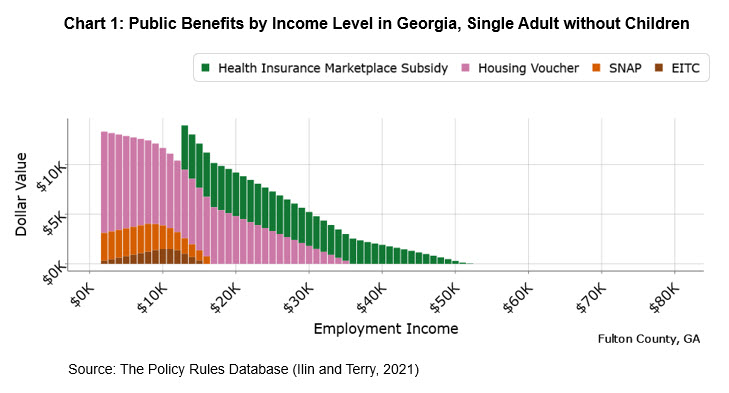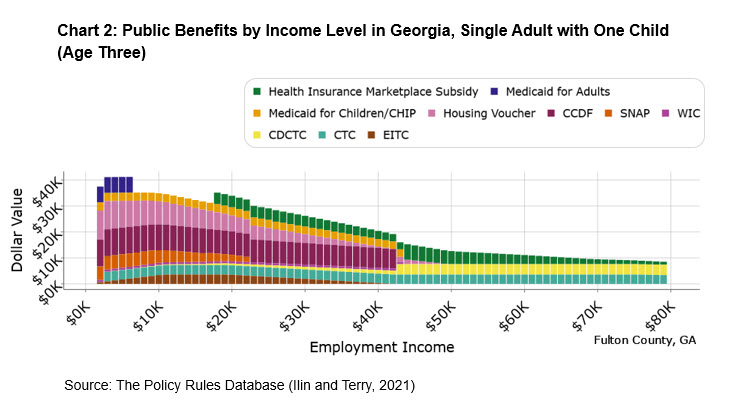
The set of public assistance programs and tax credits that comprise the US social safety net is best characterized as complex and obscure. Eligibility criteria are difficult to understand, application processes may require time-consuming in-person interviews and extensive documentation, and participation is sometimes stigmatized (Stuber et al., 2000; Finkelstein and Notowidigdo, 2019).1 As a consequence, fewer families ultimately receive benefits than are eligible. For example, we estimate that only 68 percent of families that are eligible for the Supplemental Nutrition Assistance Program (SNAP) receive it.2
This complexity and obscurity can also contribute to financial precarity even for those who receive benefits. Difficulty in understanding eligibility rules makes it challenging for families to know whether an increase in income will trigger a loss of benefits. Indeed, researchers have found that low-income families are often unaware of how benefits phase out with income. As a result, those receiving benefits often experience "frustration," "disbelief," and a sense of being "persecuted for getting a raise" when they lose benefits as a result of increased income (Romich, 2006).
The issue of complex program design extends beyond recipients. Caseworkers and counselors at organizations such as workforce development centers, health and human service agencies, and other nonprofits may find it challenging to counsel their clients on what benefits they are eligible for, what the expected monetary value of these benefits are, and how changes in income will affect their eligibility status. Furthermore, policymakers attempting to restructure existing social safety net programs need to understand how proposed changes to individual programs interact with one another and affect families' financial situations.
Policy Rules Database: the US social safety net in a single file
To provide clarity on the complexity of the US social safety net, the Federal Reserve Bank of Atlanta and the National Center for Children in Poverty have developed the Policy Rules Database (PRD). The PRD is an open-source repository that contains up-to-date program rules and provisions for all major federal and state public assistance programs, tax provisions, and tax credits in a single easy-to-use database.3 The rules for each program include any special temporary provisions.
The key purpose of the PRD is to address the complexity of programs' eligibility rules by creating a common structure and terminology. For each program, the PRD provides one tab of an Excel spreadsheet with the program rules and a user guide explaining how the program works. Policy rules are described concisely, and the complex program design is boiled down to a common set of logical and numeric fields contained in an Excel spreadsheet.4 For example, each program has a unique way to determine what portion of a family's income counts toward income eligibility. Each PRD Excel spreadsheet contains a field called "ListofCountableIncome" that specifies what income counts toward eligibility for the public assistance program in question. This standardized terminology allows for easy comparison of countable income definitions across all programs.
The PRD is a free resource that can be used to understand the general structure of the US social safety net and to learn the eligibility rules of a specific program. The PRD can also be utilized by researchers and programmers to estimate the monetary value of public assistance and tax credits for a set of households with specific demographic characteristics.
The PRD Dashboard visualization tool
To simplify the task of understanding the US social safety net, we have created the PRD Dashboard, a visualization tool that shows how public assistance programs and tax credits in the PRD intersect and how they affect almost any type of family in any county in the United States.
The PRD Dashboard shows the expected dollar amount of public assistance and tax credits a family is eligible for at different levels of employment income. Using dropdown menus, users can select any public assistance program, tax credit, location, and family type, and then visualize how benefit values change with income.
The PRD Dashboard can also be used to estimate family net financial resources and identify when wage gains make a family worse off ("benefits cliff") or no better off ("benefits plateau") financially than before the wage increase.

An example of the social safety net in Georgia
To demonstrate how the PRD Dashboard works, let's consider two types of family: a single adult without children and a single adult with one child. We will use the PRD Dashboard to determine the expected benefit amount of selected federal and state public assistance programs potentially available for these families in the state of Georgia.
We start by selecting the state and county where our hypothetical families live. In this example, we assume that both families live in Fulton County, Georgia (the county that includes most of the city of Atlanta). Next, we specify the family type by selecting the number of adults and children in the family (and the ages of the children when children are included). Finally, we select programs that are potentially available to single working adults without children—SNAP, Medicaid, Marketplace Health Insurance Subsidy, Earned Income Tax Credit (EITC), and Section 8 Housing Voucher.
We then click the "Update Charts" button and the PRD Dashboard produces a chart that shows the dollar value and composition of the selected public assistance programs and tax credits at different income levels. The calculations shown assume the hypothetical family is currently enrolled in each program and thus, continuing eligibility rules are in effect. Calculations implicitly assume that the family applied for each program, completed all paperwork correctly, and satisfied initial income eligibility requirements.
Chart 1 shows a single adult without dependents at various income levels in increments of $1,000. Although we selected "Medicaid for Adults," Medicaid does not appear on the chart because per Georgia law, adults without dependents are ineligible for Medicaid at any income level.5 The value of SNAP and the Section 8 housing voucher are both structured such that they gradually phase out with income. The EITC is designed to reward work, increasing with income up to $9,820 for this individual and phasing out after employment income exceeds $11,610. This hypothetical adult begins to receive subsidized marketplace health insurance coverage (Health Insurance Marketplace Subsidies) once the family's income reaches 100 percent of the federal poverty level (FPL), or $12,760 in 2021. The single adult is not eligible at lower income levels because the original intention of the Affordable Care Act was for this population to become eligible for expanded Medicaid. However, many states chose not to adopt that part of the law, thus leaving single adults below 100 percent of the FPL without access to subsidized health insurance on the health exchanges.

Families with dependents are typically eligible for a larger set and greater amount of public assistance than childless households. To demonstrate this difference, we use the PRD Dashboard to produce a similar chart assuming that the adult has one three-year-old child. Chart 2 shows the dollar value of public assistance programs and tax credits across income levels for this family type. The family is eligible for more public assistance programs and tax credits, including Medicaid for Children/CHIP, childcare subsidies through the Child Care and Development Fund (CCDF), the Child Tax Credit (CTC), the Child and Dependent Care Tax Credit (CDCTC), and the Special Supplemental Nutrition Program for Women, Infants, and Children (WIC). Compared with the single adult without dependents, the dollar amount of SNAP and EITC is larger for families with children. Moreover, in Georgia, adults with dependents are eligible for free health insurance through Medicaid up to 35 percent of the FPL, or $6,034.6 Note that this is below the income threshold required to be eligible for Health Insurance Marketplace Subsidies. As a result, there is an income range for which families are ineligible for either public health insurance program. This is commonly referred to as the "Medicaid coverage gap."

Additional applications of the Policy Rules Database
The PRD Dashboard is just one example of how the Policy Rules Database can be used to navigate the complexity of the US social safety net. The PRD is used in the back end of the Atlanta Fed's family of Career Ladder Identifier and Financial Forecaster (CLIFF) tools. Currently, there are three interactive tools: CLIFF Planner, CLIFF Dashboard, and the CLIFF Guaranteed Income (GI) Dashboard. CLIFF Planner is targeted toward career counselors helping individuals plot a path to financial stability. It allows users to compare the financial trade-offs to different careers and to understand how public assistance phases out as income increases as they transition to training and gain experience in their new job. The CLIFF Dashboard is geared mostly for policymakers and practitioners trying to understand the interaction between income and public assistance in the context of different careers. The GI Dashboard is being used by GI pilots across the nation to help potential participants understand how a guaranteed income may affect their receipt of public assistance.
Researchers can conduct detailed analysis of household financial resources by applying the Policy Rules Database to US Census data sets such as the American Community Survey (ACS), Survey of Income and Program Participations (SIPP), monthly Current Population Survey (CPS), and Annual Social and Economic Supplement (ASEC) of the CPS. These studies, often called microsimulations, can estimate the dollar value of each program at the household level for the nation as a whole or for specific geographic areas and demographic groups. The PRD can be applied to any data set with information on households' income and demographic characteristics.
The Policy Rules Database can also be used to simulate policy changes to public assistance programs and tax credits. For example, see Birkin et al. (2021), in which the authors simulate a change in the Child Care and Development Fund (CCDF) in Florida.
The Policy Rules Database is available at no cost to researchers, practitioners, and policymakers, provided that they work for nonprofit or not-for-profit organizations. The PRD is updated frequently; the most recent update to the PRD was in June 2021. To request access to the Policy Rules Database, visit our website.
By Elias Ilin, Federal Reserve Bank of Atlanta and Boston University, and Ellyn Terry, Federal Reserve Bank of Atlanta and University of Washington. Ilin and Terry are research associates with the Atlanta Fed's Advancing Careers initiative and are pursuing PhDs at their respective universities. The views expressed here are the authors' and not necessarily those of the Federal Reserve Bank of Atlanta or the Federal Reserve System. Any remaining errors are the authors' responsibility.
References
Birken, Brittany, Elias Ilin, Alexander Ruder, and Ellyn Terry. June 2021. "Restructuring the Eligibility Policies of the Child Care and Development Fund to Address Benefits Cliffs and Affordability." Federal Reserve Bank of Atlanta Community and Economic Development discussion paper 01-21.
Finkelstein, Amy, and Matthew J. Notowidigdo. April 2019. "Take-Up and Targeting: Experimental Evidence from SNAP." The Quarterly Journal of Economics 134, no. 3: 1505–56.
Ilin, Elias, and Ellyn Terry. 2021."Policy Rules Database."
Romich, Jennifer L. 2006. "Difficult Calculations: Low-Income Workers and Marginal Tax Rates." Social Service Review 80, no. 1: 27–66.
Stuber, Jennifer P., Kathleen A. Maloy, Sara Rosenbaum, and Karen C. Jones. 2000. "Beyond Stigma: What Barriers Actually Affect the Decisions of Low-Income Families to Enroll in Medicaid?" Health Policy and Management Issue Briefs Paper 53.
_______________________________________
1 According to Stuber et al. (2020), "welfare stigma" arises when individuals see themselves negatively and other people treat them negatively as a result of participation in the welfare program.
2 The Policy Rules Database (Ilin and Terry, 2021) applied to Annual Social and Economic Supplement of the monthly Current Population Survey. Authors' calculations.
3 Public assistance programs currently included in the PRD: Supplemental Nutrition Assistance Program (SNAP), National School Breakfast and Lunch Program (NSBP and NSLP), Housing Choice Voucher Program (Section 8), Child Care and Development Fund Subsidies (CCDF), Head Start, Medicaid/Children's Health Insurance Program (CHIP), Health Insurance Marketplace Subsidies, and Special Supplemental Nutrition Program for Women, Infants, and Children (WIC). Additional programs that are coming soon include Supplemental Security Income (SSI), Social Security and Disability Insurance Programs (SSDI), Medicare, and Temporary Assistance for Needy Families (TANF).
Taxes and tax credits included in the PRD: Federal personal income tax, state personal income tax, Federal Insurance Contribution Tax Act (FICA), state sales tax, federal Earned Income Tax Credit (EITC), state EITC, federal Child Tax Credit (CTC), state CTC, federal Child and Dependent Care Tax Credit (CDCTC), and state Child and Dependent Care Tax Credit (CDCTC).
4 The PRD includes eligibility rules related to income and assets only. It does not include provisions related to work requirements.
5 See https://www.kff.org/health-reform/state-indicator/medicaid-income-eligibility-limits-for-adults-as-a-percent-of-the-federal-poverty-level/?currentTimeframe=0&sortModel=%7B%22colId%22:%22Location%22,%22sort%22:%22asc%22%7D.
6 Ibid.


